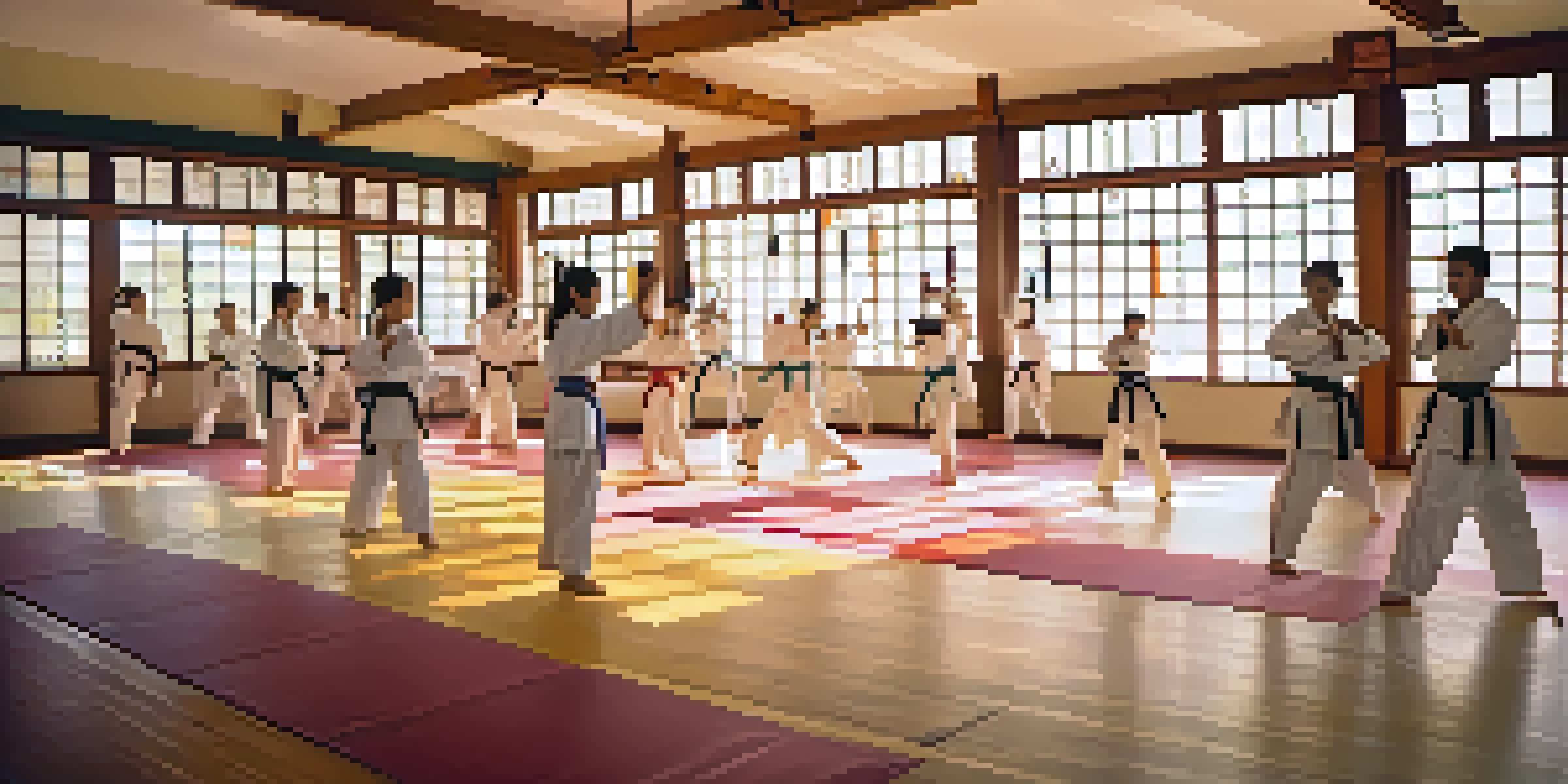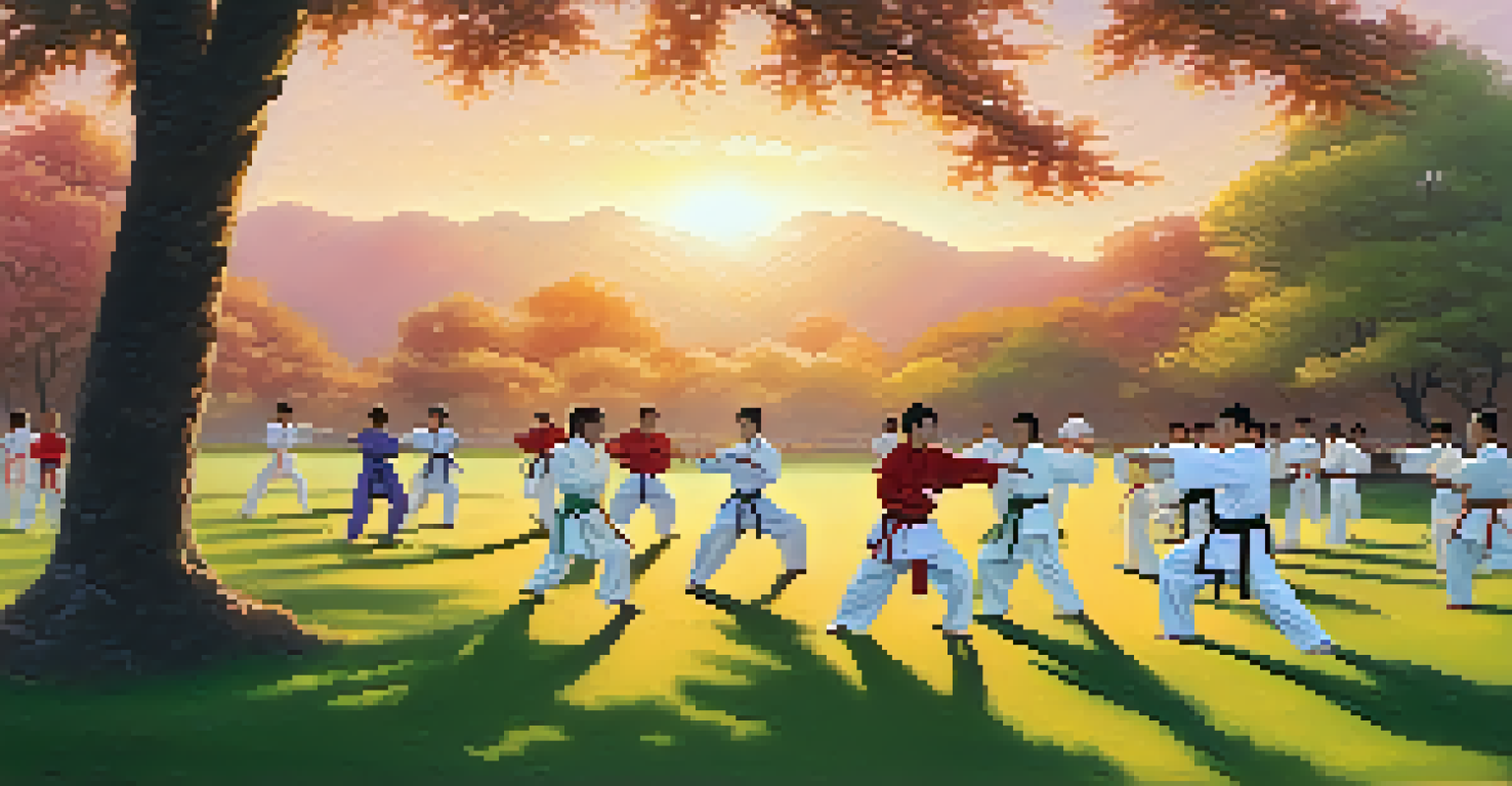Martial Arts as a Form of Physical Education in Schools

Understanding Martial Arts and Its Benefits for Students
Martial arts encompass a variety of combat practices, including disciplines like karate, judo, and taekwondo. Each style offers unique techniques and philosophies, promoting not just physical fitness but also mental discipline. By introducing martial arts in schools, students can experience a holistic approach to physical education that emphasizes both body and mind.
The ultimate aim of martial arts is not having to use them.
The benefits of martial arts extend beyond physical health. Students learn valuable life skills such as self-discipline, respect, and perseverance. These skills contribute to their overall character development, helping them become well-rounded individuals both in and out of the classroom.
Additionally, martial arts can be an excellent way to engage students who may not be interested in traditional sports. With its focus on personal achievement rather than competition, martial arts can foster a sense of belonging and encourage participation among all students, regardless of their athletic abilities.
Promoting Physical Fitness Through Martial Arts Training
Incorporating martial arts into physical education helps improve students' overall fitness levels. These practices involve various movements that enhance strength, flexibility, balance, and coordination. Unlike some conventional sports, martial arts provide a full-body workout, making it an effective way to keep students active.

Moreover, martial arts training often includes cardiovascular exercises, which can improve heart health and boost endurance. As students kick, punch, and spar, they are not only having fun but also unknowingly engaging in a rigorous fitness routine. This makes it easier for them to meet the daily physical activity recommendations.
Holistic Benefits of Martial Arts
Martial arts promote physical fitness, mental discipline, and valuable life skills, supporting students' overall development.
As students progress in their martial arts training, they often set personal goals and work towards achieving them. This goal-oriented mindset can lead to significant improvements in their physical health and confidence over time, creating a positive feedback loop that encourages continued participation.
Fostering Mental Health and Emotional Well-Being
Martial arts provide an excellent outlet for stress relief, which is especially crucial for students navigating the pressures of school life. The practice encourages mindfulness, helping students focus on the present moment and reduce anxiety. This mental aspect can significantly improve their overall emotional well-being.
Discipline is the bridge between goals and accomplishment.
Furthermore, martial arts training often includes techniques like meditation and controlled breathing, which promote mental clarity and emotional regulation. These practices help students handle their emotions better, equipping them with tools to manage stress and anxiety in a healthy way.
By encouraging self-reflection and emotional awareness, martial arts can also improve students' social skills. As they train together, students learn to communicate, cooperate, and support one another, fostering a sense of community and belonging within the school environment.
Building Discipline and Respect in Young Learners
One of the core principles of martial arts is the emphasis on discipline and respect. Students are taught to respect their instructors, peers, and the martial arts tradition itself. This respect extends beyond the dojo, helping students develop positive relationships in their everyday lives.
The structured environment of martial arts classes requires students to follow rules and routines, which fosters self-discipline. This discipline translates into better focus in academic settings and improved behavior in general. Students learn that hard work and dedication lead to personal growth and achievement.
Building Discipline and Respect
Through structured training, martial arts instill self-discipline and respect, positively affecting students' behavior and relationships.
Moreover, the belt system in many martial arts encourages students to set and achieve goals. As they progress through the ranks, they experience a sense of accomplishment, reinforcing the idea that effort and persistence pay off. This valuable lesson can motivate them to excel in other areas of their lives.
Encouraging Teamwork and Social Interaction Among Peers
While martial arts often emphasize individual achievement, they also promote teamwork and collaboration among students. Many practices involve paired drills and group exercises, fostering a sense of camaraderie as students support each other's growth. This social interaction can enhance their communication skills and build lasting friendships.
By collaborating with peers, students learn the importance of teamwork and mutual support. They realize that, while personal progress is essential, helping others can also be rewarding. This balance between individual and collective success creates a positive learning environment.
Furthermore, martial arts competitions often encourage students to cheer for their teammates, reinforcing the idea of community. This shared experience can lead to a stronger bond among students, contributing to a more inclusive and supportive school atmosphere.
Enhancing Focus and Concentration in Academic Settings
Martial arts training requires intense focus and concentration, skills that are directly transferable to academic performance. As students practice techniques and memorize forms, they learn to direct their attention effectively. This improved focus can lead to better retention of information in the classroom.
Additionally, the discipline cultivated through martial arts practice can help students manage distractions and stay on task. They learn to prioritize their responsibilities and develop effective study habits, which can significantly enhance their academic performance.
Enhancing Focus for Academic Success
The focus and concentration gained from martial arts training can significantly improve students' academic performance.
Teachers have noticed that students who participate in martial arts often display increased motivation and engagement in their studies. By integrating martial arts into school curricula, educators can harness this potential, creating a more motivated and focused student body.
Implementing Martial Arts Programs in Schools Successfully
To successfully implement martial arts programs in schools, it's essential to collaborate with qualified instructors who understand the educational environment. These professionals can tailor their teaching methods to suit the diverse needs of students, ensuring that everyone can participate and benefit from the training.
It's also crucial to promote these programs effectively within the school community. Parents, teachers, and students should understand the benefits of martial arts as physical education, fostering enthusiasm and support for the initiative. Open houses or demonstration events can help showcase the positive impact of martial arts on students.

Finally, incorporating martial arts into existing physical education curricula can create a well-rounded approach to fitness. By offering a variety of activities, schools can engage students with different interests, helping them find their passion and encouraging lifelong participation in physical fitness.